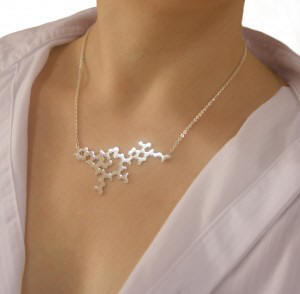Bonding with Dogs
|
|
|
|
When the moon fills the sky like a big pizza pie - it's Oxytocin...
|
 |
|
Pendant inspired by
oxytocin molecule |
In 2008 a team of scientists in Azabu University, Japan, published a paper concluding that oxytocin was secreted in significant amounts when dog owners stroked and gazed into the eyes of their dogs. When I heard about it, I contacted the team who immediately sent me their paper, in Japanese. I thought 'if this is true, then this is the start of something big'.
The paper was peer-reviewed, published in English and released to the scientific world. At first - silence. Then suddenly you could feel the scramble in universities to repeat the experiments. From Uppsala to Leipzig, Budapest to Missouri to Lincoln (yes, UK), departments were set up, papers came forth.
And the science of Human-Animal Interaction (HaI) was born. It is now called Anthrozoology, which sounds more scientific.
 Where
might we go from here?
Where
might we go from here?
There have been interesting studies of the levels of oxytocin and other hormones
- particularly cortisol and insulin - and how they connect with the heart
rate of dogs and their owners when they engage in short-term interactions. An especially interesting effect that has been observed is a decrease in levels
of cortisol (hydrocortisone). Cortisol is a hormone released in
stress which diverts sugar away from non-essential functions (such as the immune system!) so
that the
body can take the necessary action to avoid or confront danger. Long-term elevated cortisol
levels can have profound detrimental effects on the body – diabetes, heart disease, cancer
(weakened immune system.) The more you read about cortisol, the less you want to know.
The research supports a suggestion that dog owners are more likely to live longer and remain healthier than non dog owners although it has to be said this is not proven. Returning to oxytocin, the 'love hormone', in the US you can buy oxytocin nose spray. I am not sure why, probably related to its more romantic qualities, but I suppose it is to compensate people without dogs.
What about agility dogs?
During
agility training an competing, there is substantial interaction to pick up handler cues and instructions
through voice, stance and body language. The trained dog uses eyes and ears, but this is high
speed interaction at a distance. What else is involved we don't know.
After oxytocin, there is more science in the pipeline. Think about this when you handle your dogs, it is not only about repetitive technical training, waving and shouting. Maybe some day we will be able to harness hormones to help us train and bond even better.
 About
the author...
About
the author...
Kenneth Charman-Hodge has a degree in zoology from the University of London and
studied further ethology in the United States. He supports organisations fighting against dogs
being abused, and those being exploited for fur and meat in Asia.
A business analyst by profession, he shares his life with two rescued collies.
|
[bottom.htm] © Copyright Agilitynet |